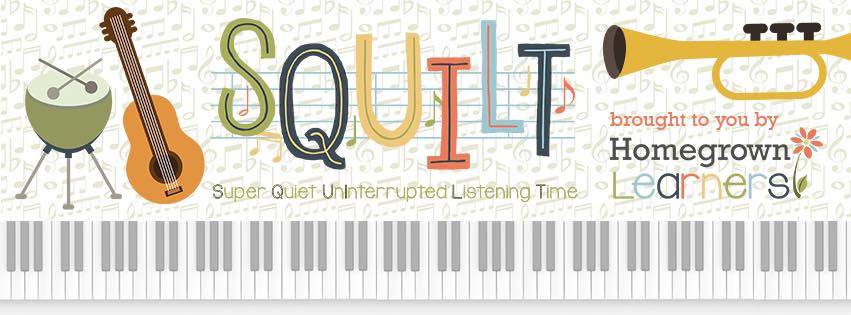One of the best ways to sneak music appreciation into your homeschool day is to incorporate it with whatever you are studying at the time.
This week we have been learning all about birds.
Two pieces naturally came to mind. Both are by the French composer, Camille Saint-Saens.
The first piece, The Aviary (from his collection The Carnival of the Animals), is a fun piece of music that does sound just like you're walking into an aviary. We did this as a SQUILT listening activity and it worked very well.
The second piece, however, is just FUN. There are so many great things to pull out of it for learning - and my kids helped me come up with something very fun, too! Today's post will focus on another piece from The Carnival of the Animals - The Cuckoo in the Depth of the Woods.
If you are unfamiliar with how SQUILT works, read this post to get the hang of it.
Download the SQUILT form and give it to your children. (Your littlest ones don't have to write, they can simply take a piece of paper and draw while listening.)
The first listening is just that: listening! Encourage your children to listen to the music (I ask for eyes to be closed). Make sure that you have gone over the elements on the SQUILT form with them, so they have an idea of what they are listening for.
If they are novice listeners, their answers may be basic at first. This is FINE. You want to encourage listening, not perfect musical analysis.
The second listening is when your children will beging to WRITE about the music. They can write complete sentences, fragments, or just individual words. I'm not picky - the object is to get the musical thoughts out!
This is my daughter's sheet - she's a pretty good listener, but she doesn't like writing. That's ok for this. She has gotten out exactly what is important about the piece!
Let me guide you through the piece, so you can help your children:
Remember: sometimes it may take several listenings. This is a short piece. Play it as many times as your children want/need.
About The Cuckoo in The Depth of the Woods
This piece (part of The Carnival of the Animals) was written in 1886 when Saint-Saens was on vacation in a little Austrian village. The composer makes each section of The Carnival of the Animals sound like a different animal. In The Cuckoo in The Depth of The Woods, you can hear a cuckoo calling out.
Dynamics
You can see from my daughter's sheet that the music is very soft throughout. The musical term for this is pianissimo (pp). There are times when the music swells (crescendo) and then falls (diminiuendo), but for the most part it is quiet and mysterious. Notice at the end there is one slighltly louder part.
Rhythm/Tempo
This piece is VERY slow (Largo). There is a repeated rhythm of the cuckoo (played by the clarinet) that is repeated over and over.
*Challenge your children to make a tally mark each time they hear the cuckoo sound. Listen carefully, because it happens a few times as an echo that you might miss! What if you ask your littlest ones to jump up in the air when they hear the cuckoo - or raise their hands?
What is the total number of times you hear the cuckoo?(We counted 21!)
Instrumentation
Piano and clarinet are all you will hear in this piece. The piano is a member of the Percussion family and the clarinet is a member of the Woodwind family.
Mood
Mysterious, somber, mournful - any adjectives will do. Encourage your children to come up with their OWN feelings about the piece.
Follow Up
- You can watch the entire Carnival of The Animals - as a Looney Tunes video - on YouTube. Kids LOVE this!
- Maestro Classics has a wonderful CD of The Carnival of the Animals that we enjoy.
- Here is a Carnival of the Animals FREE Unit Study
- Complete Cuckoo Notebooking (we are doing a bird unit and notebooking many birds), using Notebooking Pages.
*Notebooking Pages is one of my favorite resources for our homeschool. We use Notebooking Pages in every area of the curriculum. It is WELL worth the money.
And, if you are interested in more SQUILT lessons, visit SQUILT Music, where I offer volumes of SQUILT lessons grouped by musical era!






